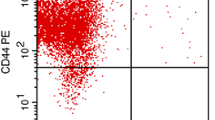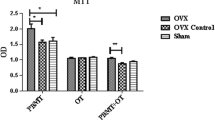Abstract
To design an estrogen and phenol red free medium for cell culture and check its effectiveness and safety on osteoblast growth it is necessary to maintain the estrogen receptors free for tests. For this purpose, we tested some modifications of the traditional culture media: estrogen depleted fetal bovine serum; estrogen charcoal stripped fetal bovine serum and phenol red free α-MEM. The aim of this work is to examine the effects of its depletion in the proliferation, differentiation, and toxicity of mesenchymal stromal cells differentiated into osteoblasts to obtain an effective interference free culture medium for in vitro studies, focused on non-previously studied estrogen receptors. We performed viability tests using the following techniques: MTT, alkaline phosphatase specific activity, formation of mineralized matrix by Alizarin technique and analysis of SEM/EDX of mineralized nodules. The results showed that the culture media with estrogen free α-MEM + phenol red free α-MEM did not impact viability, alkaline phosphatase activity and mineralization of the osteoblasts culture compared to control. In addition, its nodules possess Ca/P ratio similar to hydroxyapatite nodules on the 14th and 21st day. In conclusion, the modified culture medium with phenol red free α-MEM with estrogen depleted fetal bovine serum can be safely used in experiments where the estrogen receptors need to be free.





Similar content being viewed by others
References
Berthois Y, Katzenellenbogen JA, Katzenellenbogen BS (1986) Phenol red in tissue culture media is a weak estrogen:implications concerning the study of estrogen-responsive cells in culture. Proc Natl Acad Sci USA 83:2496–2500
Camolezi FL, Daghastanli KPR, Magalhães PP, Pizauro JM, Ciancaglini P (2002) Construction of an alkaline phosphatase-liposome system: a tool for biomineralization study. Int J Biochem Cell Biol 1282:1–11
Foster TC (2012) Role of estrogen receptor alpha and beta expression and signaling on cognitive function during aging. Hippocampus 22:656–669
Ge Y, Chen D, Xie L, Zhang R (2006) Enhancing effect of daidzein on the differentiation and mineralization in mouse osteoblast-like MC3T3-E1 cells. Yakugaku Zasshi 126:651–656
Gregory CA, Gunn WG, Peister A, Prockop DJ (2004) An alizarin red-based assay of mineralization by adherent cells in culture: comparison with cetylpyridinium chloride extraction. Anal Biochem 329:77–84
Heaney RP, Recker RR, Saville PD (1987) Menopausal changes in calcium balance performace. J Lab Clin Med 92:953–963
Hemeda H, Giebel B, Wagner W (2014) Evaluation of human platelet lysate versus fetal bovine serum for culture of mesenchymal stromal cells. Cytotherapy 16:170–180
Imamov O, Shim GJ, Warner M, Gustafsson JA (2005) Estrogen receptor beta in health and disease. Biol Reprod 73:866–871
Lee WL, Cheng MH, Tarng DC, Yang WC, Lee FK, Wang PH (2013) The benefits of estrogen or selective estrogen receptor modulator on kidney and its related disease-chronic kidney disease-mineral and bone disorder: osteoporosis. J Chin Med Assoc 76:365–371
Lerchbaum E (2014) Vitamin D and menopause-A narrative review. Maturitas 14:S0378–S5122
Liu X, Chen B, Chen L, Ren WT, Liu J, Wang G, Fan W, Wang X, Wang Y (2013) U-Shape suppressive Effect of phenol red on the epileptiform burst Activity. PLoS one 8:e60189
Millán JL (2006a) Mammalian alkaline phosphatases from biology to applications in medicine and biotechnology. Wiley, Hoboken, pp 1–322
Millán JL (2006b) Alkaline phosphatases. Structure, substrate specificity and functional relatedness to other members of a large superfamily of enzymes. Purinergic Signal 2:335–341
Millán JL (2013) The Role of Phosphatases in the Initiation of Skeletal Mineralization. Calcif Tissue Int 93:299–306
Mosmann T (1983) Rapid colorimetric assay for cellular growth and survival: application to proliferation and cytotoxicity assays. J Immunol Methods 65:55–63
Osborne CK, Schiff R (2005) Estrogen-receptor biology: continuing progress and therapeutic implications. J Clin Oncol 23:1616–1622
Richart RM, Lindsay R (1984) Osteoporosis and its relationship to estrogen. Contemporary Ob/Gyn 24:201–224
Saji S, Jensen EV, Nilsson S, Rylander T, Warner M, Gustafsson JA (2000) Estrogen receptors α and β in the rodent mammary gland. Proc Natl Acad Sci USA 97:337–342
Simão AMS, Beloti MM, Rosa AL, De Oliveira PT, Granjeiro JM, Pizauro JM, Ciancaglini P (2007a) Culture of osteogenic cells from human alveolar bone: a useful source of alkaline phosphatase. Cell Biol Int 31:1405–1413
Simão AM, Beloti MM, Cezarino RM, Rosa AL, Pizauro JM, Ciancaglini P (2007b) Membrane-bound alkaline phosphatase from ectopic mineralization and rat bone marrow cell culture. Comp Biochem Physiol A Mol Integr Physiol 146:679–687
Simão AM, Yadav MC, Ciancaglini P, Milla´n JL (2010) Pro-teoliposomes as matrix vesicles’ biomimetics to study the initiation of skeletal mineralization. Braz J Med Biol Res 43:234–241
Simioni AR, Martins OP, Lacava ZG, Azevedo RB, Lima EC, Lacava BM, Morais PC, Tedesco AC (2006) Cell toxicity studies of albumin-based nanosized magnetic beads. J Nanosci Nanotechnol 6:2413–2415
Simoncini T, Fornari L, Mannella P, Caruso A, Garibaldi S, Baldacci C, Genazzani AR (2005) Activation of nitric oxide synthesis in human endothelial cells by red clover extracts. Menopause 12:69–77
Simonelli C, Weiss TW, Morancey J, Swanson L, Chen YT (2005) Prevalence of vitamin D inadequacy in a minimal trauma fracture population. Curr Med Res Opin 7:1069–1074
Somjen D, Katzburg S, Sharon O, Grafi-Cohen M, Knoll E, Stern N (2011) The effects of estrogen receptors α- and β-specific agonists and antagonists on cell proliferation and energy metabolism in human bone cell line. J Cel Bioch 112:625–632
Souza ID, Cruz MAE, Faria AN, Zancanela DC, Simão AMS, Ciancaglini P, Ramos AP (2014) Formation of carbonated hydroxyapatite films on metallic surfacesusing dihexade-cyl phosphate–LB film as template. Colloids Surf B 118:31–40
Tekkatte C, Gunasingh GP, Cherian KM, Sankaranarayanan K (2011) “Humanized” stem cell culture techniques: the animal serum controversy. Stem Cells Int 2011:504723
Terauchi M (2011) Bone and calcium metabolism in menopause transition. Clin Calcium 21:1353–1359
Welshons WV, Wolf MF, Murphy CS, Jordan VC (1988) Estrogenic activity of phenol red. Mol Cell Endocrinol 57:169–178
Whedon GD (1981) Osteoporosis. N Engl J Med 6:397–398
Zhao Q, Liu X, Zhang L, Shen X, Qi J, Wang J, Qian N, Deng L (2013) Bone selective protective effect of a novel bone-seeking estrogen on trabecular bone in ovariectomized rats. Calcif Tissue Int 93:172–183
Author information
Authors and Affiliations
Corresponding author
Rights and permissions
About this article
Cite this article
de Faria, A.N., Zancanela, D.C., Ramos, A.P. et al. Estrogen and phenol red free medium for osteoblast culture: study of the mineralization ability. Cytotechnology 68, 1623–1632 (2016). https://doi.org/10.1007/s10616-015-9844-2
Received:
Accepted:
Published:
Issue Date:
DOI: https://doi.org/10.1007/s10616-015-9844-2




